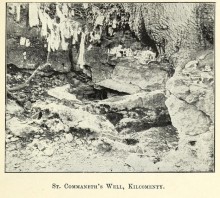I cannot tell you how long it's taken me to track down the location of this site... variant spellings and unfamiliarity with the area did not help. But anyway it sounds superb so all this is worth the effort. I'd love to visit.
This is a naturally curious place, with a stream disappearing into the ground and reappearing: it's no wonder it's replete with folklore and Christianisation. I advise a glance at the Historic Environment Viewer map to see where the well, stream, 'bed', and bullauns all are.
This is an extract from an article on 'The antiquities of the Parish of Kilcomenty' in The Journal of the Royal Society of Antiquaries for 1904: About 30 yards east of the graveyard, a rapid stream which there issues from the ground is called St. Commaneth's Well. This stream flows from Ballinahinch, about two miles distant, and close beside the saint's bed; it is carried underground for nearly 200 yards, emerging at and forming the well; then, turning sharply by the south wall of the graveyard, it finally empties itself into the bog of Shower.
One of the legends told concerning the well is that long ago it was situated close by the stone known as St. Commaneth's Bed, but that some cattle having been accidentally allowed to sully its waters, the well in a single night moved down to its present site.
Two of the traditional trout said to frequent holy wells in Ireland are supposed to be here.
Over the well, completely shading its waters, are four ancient trees - one sallow, one whitethorn, and two ash. Those two last are in reality one enormous tree, which, near the lower part of the trunk, is divided in two, and its branches and the hollow by the well are covered with rags and votive offerings of every description, deposited by pilgrims who have made their rounds.
The summer of 1902 was exceptionally dry in North Tipperary, the month of August being phenomenally so. Springs, wells, and streams that in living memory had never been known to do so, ran dry; and St. Commaneth's Well formed no exception to the general rule, for it must be recorded that we failed to find even one drop of water within its usually brimming basin.
The rounds practised here are seven in number. Having taken seven pebbles from the stream running from the well, and having repeated the Lord's Prayer, Hail Mary!, Creed, and Gloria, the pilgrim throws one of the pebbles back into the brook, and proceeds to walk round the well. Following the course of the water for a time "sunwards," through the field south of the stream, he crosses it by a small bridge and enters the graveyard by a gate at the extremity of the south wall. Proceeding along a well-worn pathway by its north and east sides, he quits its precincts by a stile, which brings him to the well again, where he kneels and prays, and so on, until the appointed number of rounds are performed. While Mr. Westropp and I were in the cemetery, a country woman and two children "were making their rounds."
Close by the spot where the water of the stream disappears for a space under ground rests the traditional bed of the saint, lying north of the stream, and nearer to the road than the graveyard and well. It is a large irregular block of brownish sandstone, 8 feet long, and 4 feet 9 inches wide, extreme measurements, and stands about 2 1/2 to 3 feet high. The highest end is to the west, and here is a large and deep bullaun. To the west of this is a shallow, dish-like bullaun, and there are traces of two or more basins. Two sets of scorings are to be found on the stone; that nearer the top consists of six irregular broad strokes, not ogamic in character, while the set lower down consists of four slight scores. These markings are reputed to represent the impressions of the saint's ribs and hands. There's some extra folklorey information in Lives of the Irish Saints by John O'Hanlon. He mentions that the prayers at the well are good for "bodily and mental ailments."
He says of the trout: "The following is a local legend. A person of the neighbourhood, at one time, scorning to respect the well, took one of these trout home, and made an effort to roast it; nothing but blood appeared, and the rascal had to bring the trout back to the well; but from that day forward, the family has not had good luck."
He mentions of the bed: "About two hundred yards noth-east of the well, in the midst of hawthorn and alder trees, there is a great Druidic rock basin, of brown sandstone, quite unlike stone of the immediate place, which is limestone," and that the basins are "always full or half full of water."
I love the way he mixes Druids and saints. He says "There is no doubt, that the stone lay, in its present position, long before the period of the patron saint. On the conversion of the Druids, he may have used the basins for baptizing the early Christians of the place, and may have rested on it occasionally. There is nothing impossible or improbable in this presumption, and tradition may be perfectly correct."
|
 Posted by Rhiannon
Posted by Rhiannon
10th February 2017ce
Edited 10th February 2017ce |


 Posted by Rhiannon
Posted by Rhiannon
